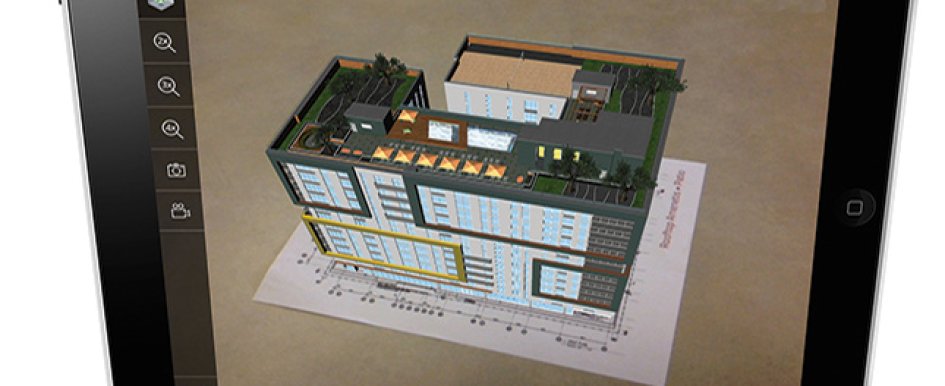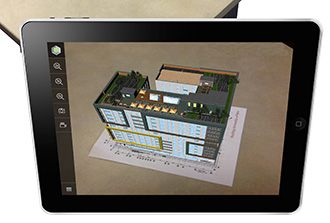
For those who have not heard the term “augmented reality” (AR), you will soon. In the next few years, the application of augmented reality will impact every phase of our design and construction projects. The promise of AR presents the possibility of walking into a building, holding a smartphone or tablet up to a wall and being able to see all of the pipes and conduits in that wall. It offers the potential to see what is planned in an empty space by “looking through” a smart device. AR is not X-ray vision; however, it will have a large impact on this industry during the next few years.
What is Augmented Reality?
You may already be using AR with tools such as Star Chart or Sky Map, Layar or Yelp Monocle. These are all AR applications that can lead you to a restaurant or a constellation in the sky. Augmented reality is a technology application and methodology to supplement and expedite access to information in context with reality.

Why is this important? Science has shown statistically that somewhere between 60 and 70 percent of us are visual learners. This means that the better we can see something the better we can comprehend and remember it. The power of AR is the ability of this application to help everyone understand and improve how we access information within our built environment.
Both during the construction process and in the operations and maintenance of our facilities, AR can place a vast wealth of images and construction or facility data at your fingertips.
How Does it Work?
One of the easiest ways to showcase the application of AR is to combine it with BIM. In this application, a BIM file of a facility during construction is created, documenting the location of all building utilities behind walls, above ceilings and underground. Through the implementation of an AR application using a tablet or smartphone, the facility user can walk into a room and see the utilities behind walls by simply pinpointing his location and referencing the correct model. The 3-D model reveals where the utilities in the room are located—an instant tool for facility maintenance information and a game changer when this project turn-over product can replace stacks of plans and binders.
There are some current drawbacks to this application, but technology advancements may soon overcome these. GPS does not effectively function inside all buildings, meaning the location within the model must be set manually.
However, advancements in mobile phone locators, wireless Internet and other applications will soon solve the self-location problem. The other issue is the accuracy of system(s) installation inside the model. If the BIM documentation process is not enforced, for example, the view of what is behind a wall could be useless. The development of a strong BIM protocol is essential.
There are alternatives to the issues surrounding GPS location inside a building. One is the use of quick reference (QR) code stickers in a facility. The QR code stickers are a link to the BIM. A facilities person can walk into a room, scan the QR code and instantly be placed inside a 3-D model of the room. Then, using a smartphone or tablet, he can view the concealed elements of the room. Advancements are being made very quickly in the area of Bluetooth and wireless technology that will soon improve this process.
Case Studies
The following paragraphs provide a brief overview of three recent case studies in the use of augmented reality in the construction industry.
A company that designs and manages university housing across North America wanted a better way to market their units to students. Through a combination of BIM and SmartReality, they were able to have prospective tenants use their smartphone or tablet to look at unit floor plans in a virtual 3-D world. Not only could they view the unit, but they could also move through the space, snap pictures or even play a short video to show friends and parents—an effective marketing tool.
For the last few years in the construction world, we have been seeing BIM models used to produce concrete lift drawings. With the AR application, you can not only view the foundation plan for a concrete lift drawing from one side, but also turn the sheet in the AR application and look at all sides of the pour. No need for field crews to know how to manage or manipulate a BIM model. This ability to view the model from any angle or perspective means no concealed conditions that might be missed in a single-view lift drawing. Simply put, better visualization is a risk reduction tool.
Finally, for contractors, AR applications such as SmartReality are a marketing game changer. For example, imagine walking into an interview with an owner and in place of the old site utilization drawing, showing the owner a 3-D image of the site, including cranes, traffic patterns and more.
Wearable Devices
According to the 2014 Construction Technology Report, 62.4 percent of commercial builders are using a BIM solution. While this still doesn’t match the level of software adoption among other categories such as invitation to bid and estimating, it is a number that grows every year. The wider use of BIM means it can be applied more creatively, as all project participants become more familiar with the technology.
The potential of AR when combined with BIM software on mobile devices is evident, but what about when combined with wearable devices? Many have heard of Google Glass, a heads-up display worn like glasses that allows the wearer to interact with the world through the lens. Companies such as Epson are developing even more advanced and intuitive wearable devices, such as the Moverio Smart Glasses, that fully immerse the wearer in the augmented reality created by the lenses. This technology could easily be built into the construction safety goggles of the future.
Alongside AR lies virtual reality (VR). Instead of altering the reality you see with computer imagery and interactivity like AR does, VR creates an entirely new reality. Oculus is the leading hardware developer in this field, and though their Rift headset is five times the size of smart glasses such as Moverio, the experience also feels five times the size. While these VR wearables are less practical for the jobsite, they still provide ample opportunities to interact with building plans for training, business development or client review and visualization purposes. Combined with depth sensors such as the Leap Motion Controller, they can even be manipulated with motion gestures from the user’s hands. Mice, keyboards and even touch screens will one day be a thing of the past thanks to this exciting combination of hardware.
Drones and iBeacons
Another advancement being tested on construction jobsites is drone technology. From transporting and placing materials, performing tasks dangerous to workers and surveying terrain, drones will only grow in usefulness. Combined with GPS and geospatial technology in augmented reality solutions, drones will become better equipped and more precise at coordinating jobs on-site. Imagine a drone running SmartReality flying high above a plot of dirt, relaying a real-time, life-size image rendering of how a proposed building will actually look.

In addition to drones, workers could see a more advanced mobile network on their jobsites soon, not only enhanced by augmented reality but also with connectivity to their fellow workers and machines. iBeacons, developed by Apple, are already being implemented in baseball stadiums and on jobsites around the country to better integrate push notifications, safety alerts and sharing of exact site locations among project participants within a measured radius. Technology like iBeacons could allow an unprecedented level of sharing documents, models and even data gathered from AR devices on construction jobsites.
Augmented reality holds much potential that we have not even begun to see on projects, but companies continue to research. They are exploring mobile apps, web-based software, mobile devices, wearable devices and even drones that can implement interactive data like never before. The tipping point will be at the convergence of connectivity, deliverability and cost. When companies can easily secure and establish the networks to support AR data, deliver those networks across all project participants and do so at the lowest cost possible, augmented reality will become a common feature of every construction project.
